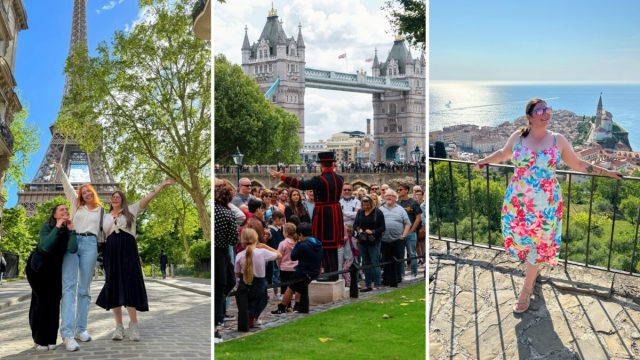So you’re planning an epic Euro summer, perhaps heading to Tuscany or the French Riviera or the Greek Islands, or any of the great European cities from Lisbon to Paris to Prague to Rome. I myself have had a Euro summer the past several years, spending weeks (sometimes months) traveling all across the European continent.
I have literally been to all corners of Europe in the summer months, and am here to share with you this one incontrovertible truth: summer tends to be the most crowded and hottest time to travel in Europe – especially the months of July and August.
Well, okay, *most* of Europe – you can certainly find plenty of less-crowded corners, and the weather doesn’t tend to be as oppressive if you head to Scandinavia, the Baltics, or Iceland. BUT, on the whole, summer can be a rough time to be in the major metropolitan centers of Europe.


(And yes, I truly do mean almost all of Europe. The heat and crowds can and will find you whether you’re in Barcelona or London or Budapest.)
I realize, though, that summer is often the only time people can travel, from teachers to families with kids. So, if you’ve got a Euro summer dream and not much flexibility in your travel dates, here are my top tips for making the most of summer travel to Europe.
Tips for Europe summer travel
Note: Yes, I’m aware that “Europe” comprises up to 50 different countries, and that travel experiences can vary from person to person and from country to country. Yes, I’m going to make some generalizations here. But these tips are broadly applicable to most countries in Europe during the busy summer months, in my experience. (And my experience is that I’ve visited 30+ countries on the European continent, most of them during the summer!)
1. Be strategic with your timing
“Summer” can be a broad timeframe when it comes to traveling in Europe. The “summer season” can honestly apply to any time between mid-May and mid-September in most places; this is the high season in almost every country in Europe.
IF your travel plans are flexible enough to travel at either end of high season (or in the shoulder season that surrounds it), you’re going to have a much more enjoyable trip. Traveling in most parts of Europe in May or September will still be busy, but you won’t find the same overwhelming crowds (and usually not the heat, either) that you’ll find in, say, late July.


If you really only have the time off from late June through August, however, you can still make your trip slightly less chaotic if you try to plan your time in major cities on weekdays instead of weekends, and do a quick search about national and school holidays in the country you’re visiting to try to avoid the busiest times when locals will also be traveling.
2. Choose the right destination
Listen, I know that your dream Euro summer probably takes place in France or Italy or Greece or Spain… but so does everyone else’s! I promise that summer on the Amalfi Coast or Santorini is NOT going to be as romantic as all the Instagram photos make it seem. The most Insta-famous cities and regions across Europe are usually hot as hell in the summer, hotels are expensive, museums sell out, and it can be downright unpleasant to be there.
Consider lesser-visited parts of Europe if you’re going to be visiting in the height of summer.
For example, head to places in the Nordic region (Norway, Sweden, Finland), the Baltics (Estonia, Latvia, Lithuania), parts of the Balkans (like Slovenia, Albania, and parts of Croatia), and even Poland or Wales to find places that are a lot less crowded!




Places in northern Europe (especially Scandinavia and parts of the UK) also tend to be a bit cooler than the rest of mainland Europe, even during the height of summer.
(The exception here is Iceland; Iceland is nice and cool in the summer, but summer is the most popular time to visit. If you’re planning a summer Iceland road trip, be sure to book things like your rental car and hotels months and months in advance.)
3. Don’t ONLY visit the famous cities
The “big” cities in Europe (think: London, Paris, Rome, Barcelona, Amsterdam, etc.) are always going to be the busiest in the summer months. And some of these cities – like Venice, Barcelona, and Amsterdam – are actively trying to dissuade the crush of summer tourists.


I’m not saying to completely skip these cities if they’re on your bucket list. But instead of planning a week or more in only big cities, consider pairing a popular big city with a smaller city where your tourist dollars will go farther and you can enjoy yourself a bit more.
For example:
- Instead of Paris, head to Lyon or Bordeaux or the Loire Valley.
- Instead of London, try Liverpool or even Cardiff in Wales.
- Instead of Venice, head to Treviso or Trieste.
- Instead of Rome, go to Bologna or Verona.
- Instead of Barcelona, explore Valencia or San Sebastián or Granada.
- Instead of Santorini, head to Naxos or Paros.
- Instead of Amsterdam, head to Leiden or Haarlem.
- Instead of Lisbon, go to Évora or Coimbra.
- Instead of Vienna, try Austria’s “second city” of Graz.
- Instead of the Amalfi Coast or Cinque Terre, go to Salerno and the Cilento Coast.
- Instead of Dubrovnik, head to Rovinj or Korčula.
The big capital cities of Europe are great, but they are not all there is to do in a country! Don’t be afraid to branch out, especially during the busy summer months.


4. Pack for it to be hot
Climate change is coming for Europe, and fast. In 2025, the Mediterranean Sea hit a record high temperature in June with water temps at 30 degrees C (86 degrees F), and countries like Spain and the UK recorded their hottest Junes ever on record.
In many countries in the northern half of Europe, the buildings are old and built to keep heat IN in traditionally cooler climates. But, with Europe rapidly warming, that means that those buildings now just work as incubators that are very hard to cool down once they get hot.
Heat waves are hitting Europe earlier and earlier each year, and it’s not uncommon now to have places like Turkey and Greece battling wildfires as early as mid-June.
So, whether you’re visiting a place you expect to be hot like Spain or Southern Italy, or a place that you typically associate with cooler weather like Scotland, you’d better prepare and pack for warm weather.


A city like Florence or London or Paris will FEEL hotter than it is because of the architecture that is meant to trap heat in. (And this goes double for any city with underground metro systems and poor ventilation; the London Tube and Paris Metro, for example, are notorious for feeling like saunas when the temperatures rise.)
Be prepared with light clothing, sun protection (good sunscreen and a hat are musts), and a fan. I literally swear by this handheld electric fan with a really long battery life. It’s the only way I’ve survived European heat waves in the last few years!
5. Look for hotels with AC
Speaking of heat waves, keep in mind that many countries in Europe do not embrace air conditioning. The French believe it will make you sick, Germans think it’s too expensive, and again in many places it never used to be needed.
So, as you’re planning your Euro summer, if you know that you have trouble sleeping when it’s hot, I cannot stress enough how important it is to book a hotel with air-conditioned rooms. Double and triple check that AC is available if it’s important to you (look at listings, read reviews, and check photos for an AC unit).


And look, yes, it may “mark me as an American” that I care about an air conditioned room this much, but I honestly don’t care. I know I become a cranky bitch when I’m overheated, so you best believe I WILL go out of my way to be comfortable when on a dream trip.
RELATED: DOs and DON’Ts for Your First Trip to Europe
6. Don’t worry about “looking touristy”
Every summer I see videos online giving tips on what to wear in Europe in the summer. And a lot of these videos are suggesting completely impractical outfits with lots of layers/accessories, strappy sandals, and purses that will get you pick-pocketed faster than you can say “Euro summer.”
I’m not saying you need to completely leave your fashion sense at home. But I am saying that people in the places you’re traveling don’t really care what you’re wearing.
In a situation where you’re going to be walking a ton and it’s likely to be hot, please please pack and dress for comfort first! You can still look cute in a summer dress and some white sneakers (it’s honestly what all the girls are wearing in Europe anyway), while at the same time actually being comfortable.
There’s nothing worse than being hot and dealing with crowds while ALSO being overheated and having very sore feet.


My go-to shoe line-up for any Europe summer trip is always one pair of sneakers (white sneakers are IN in Europe; I have a pair of these Reeboks, and these Dr. Scholl’s sneakers are also a fan favorite) and one pair of walking sandals (I love my Teva Verra sandals for Europe, as you can get away with dressing them up a bit, too).
You’re likely going to stand out as a tourist no matter what you wear – because you ARE a tourist. So you may as well not stress about it and just be comfy.
7. Beware of scams and pickpockets
Like I said, you’re probably going to be read for a tourist no matter what you’re wearing since you’re going to be visiting touristy spots, taking photos of things, probably not speaking the native language, and perhaps making typical tourist mistakes. This is fine! It’s normal.
But since it’s probably going to be obvious that you’re a visitor, you’re also going to be an easier target for scammers and pickpockets.
Scams and pickpockets are rife in the large cities of Europe, and these types of people ramp up their operations during the busy summer months.


A few tips for keeping yourself (and your stuff) safe:
- Be extra aware of your surroundings in crowded places (like around major tourist attractions and on busy public transit).
- Beware of “bracelet men” in places like Paris, Rome, Milan, etc. They will grab your arm and try to tie a woven bracelet on your wrist and then demand money for it. (Same goes for people trying to hand you flowers; say no and do not touch anything.)
- Also beware of petition scams, where groups of teenagers (usually teenage girls) will try to get you to sign a petition for some “charity” cause. The charities are always fake, and it’s just a distraction for them to rob you.
- Watch out for fake taxis; never get into a car at an airport or train station that is not an official taxi, or that you didn’t pre-book or order through a rideshare app. It’s also smart to look up set taxi prices in advance.
- Carry a cross-body bag with a zipper whenever possible; I highly recommend bags with theft-proof features, but any crossbody bag with a zipper is better than a regular handbag or backpack.
- Watch out for your phone! Phone theft has been rampant in big European cities; thieves will snatch them out of your hand while riding by on a bike/motorbike, or grab them on public transit just before the doors close. If you need to use your phone in public, I swear by using a phone lanyard these days!
ALSO READ: How to Keep Your Money and Valuables Safe While Traveling
8. Start your days early
To avoid the worst of the crowds and the worst of the potential heat, consider getting up earlier than you normally would to start your sightseeing before most other people*.


You won’t necessarily be able to go shopping or visit museums before 9 or 10 a.m. in many cities, but you can sightsee outdoors, visit churches, stroll through parks, and more in the early morning hours. And, in many parts of Europe, even 8 a.m. can be considered “early.”
You can always take a break at your hotel in the afternoon (embrace that Spanish siesta life!), and then head back out again around dinnertime.
*This tactic isn’t necessarily going to net you completely empty sites (the Trevi Fountain in Rome is never empty these days, for example, no matter when you go), but you at least have a good shot at encountering less/smaller crowds.
9. Pre-book as much as you can
Look, I’m not here to tell you to skip the famous cities or popular tourist spots. If you’re taking your dream trip to Europe, of course you’re going to want to go to Paris or Venice or whatever other city is on your bucket list. I would never suggest you skip them entirely.
But what I WILL suggest is that you go in with realistic expectations, and plan to pre-book everything. Flights, hotels, trains, rental cars… those are givens. If you have your heart set on specific museums, tours, and even restaurants, you also need to be booking those weeks in advance.


Everything sells out these days. Tickets to the Louvre in Paris. Food tours in Rome. Tickets to visit Anne Frank’s House in Amsterdam. Tables at popular restaurants, even on weekdays. Book your absolute must-dos as far in advance as you possibly can.
Pro tip: If you forget to book something, like perhaps a ticket to visit the Louvre, check on a site like GetYourGuide to see if any companies are selling combo tickets – like maybe the Louvre and a Seine cruise. *Sometimes* tour companies have access to tickets you can’t buy on your own, and you might luck out and be able to get a last-minute ticket this way. It’s not guaranteed, but it’s worth a try.
10. Pack your patience
Lastly, I’m going to need you to pack a bit of patience with you. A summer trip to Europe can be incredible! But it can also be exhausting and unpredictable at times.
In June 2025 alone, some major cities in Europe saw anti-tourism protests; in Paris the Louvre shut down for a day when the staff went on strike, and the Eiffel Tower closed down another day due to excessive heat; and wildfires have already been plaguing Greece, forcing evacuations in places like Crete.
You can almost count on extreme weather (be it heat or flooding) snarling up travel plans, and there’s also always the possibility of train or even airport strikes on top of the large crowds in major tourist centers. So just… be mentally prepared to roll with the punches at times.


And you also need to be prepared to deal with all the other tourists! Traveling in Europe in the summer means you’re never going to be alone. You’re probably going to have to wait in line – to enter museums, get a table at popular restaurants, or even take photos at Insta-famous locations.
If you’re not prepared to be a kind and patient tourist yourself, then I would highly, highly recommend choosing another time to travel.
Having a Euro summer can be absolutely incredible – as long as you’re prepared!
Have you traveled anywhere in Europe during the summer months?


Amanda Williams is the award-winning blogger behind A Dangerous Business Travel Blog. She has traveled to more than 60 countries on 6 continents from her home base in Ohio, specializing in experiential and thoughtful travel through the US, Europe, and rest of the world. Amanda only shares tips based on her personal experiences and places she’s actually traveled!







